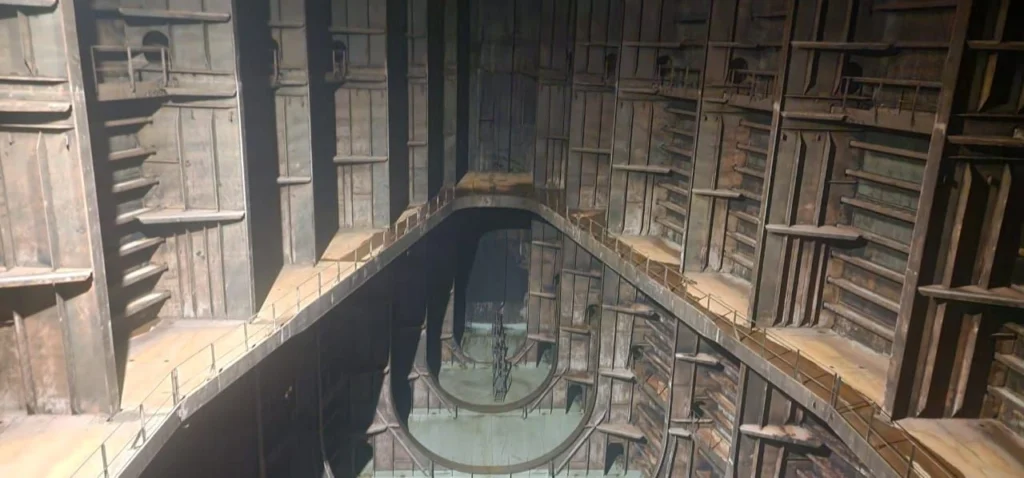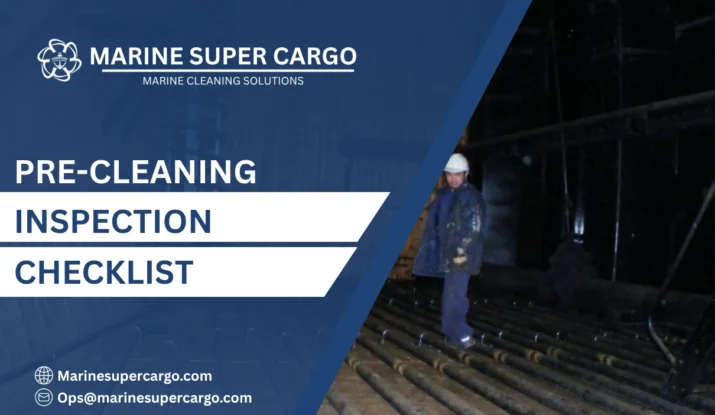Why an Pre-Cleaning Inspection Checklist Matters Before Tank Cleaning
A comprehensive Pre-Cleaning inspection checklist prevents accidents, ensures regulatory compliance, and protects crew safety during cargo tank cleaning operations. Before commencing any tank cleaning activity, vessel operators must systematically verify all safety parameters using a detailed inspection checklist.
The Pre-Cleaning inspection checklist serves as the foundation for safe tank entry and cleaning procedures. Without proper pre-cleaning verification through an inspection checklist, vessels risk crew injuries, environmental violations, and operational delays. Every item on the inspection checklist requires careful attention from bow to stern.
Marine Super Cargo emphasizes that a thorough inspection checklist combined with proper tank cleaning procedures ensures operations meet MARPOL and IMO standards while protecting personnel and environment.
Essential Components of Tank Cleaning Pre-Cleaning Inspection Checklist
Documentation Review Section
The Pre-Cleaning inspection checklist begins with documentation verification. Review previous cargo records, Material Safety Data Sheets (MSDS), and cargo tanks specifications. Confirm all permits and work authorizations are current before proceeding with the inspection checklist.
Check that the Oil Record Book or Cargo Record Book contains accurate entries per MARPOL Annex I requirements. This Pre-Cleaning inspection checklist item ensures traceability and compliance throughout operations.
Tank Isolation Verification
Your Pre-Cleaning inspection checklist must confirm complete cargo tank isolation. Verify all cargo lines, suction lines, and discharge lines are properly blanked or double-valved. Check that both port and starboard manifold connections are secured.
Inspect crossover valves ensuring tanks remain isolated from adjacent spaces. The Pre-Cleaning inspection checklist should document valve positions photographically when feasible. Proper isolation prevents cargo transfer during cleaning operations.
Atmosphere Testing Requirements
Atmosphere testing forms a critical Pre-Cleaning inspection checklist component. Measure oxygen levels, hydrocarbon concentrations, and toxic gas presence throughout the tank from top to bottom. The inspection checklist requires readings at multiple levels—overhead, mid-height, and bottom plating.
Document all measurements on the Pre-Cleaning inspection checklist with date, time, and tester identification. Oxygen levels must exceed 21% while hydrocarbon concentrations remain below 1% LEL before tank entry. Repeat testing appears multiple times on the inspection checklist throughout operations.

Safety Equipment Verification on Pre-Cleaning Inspection Checklist
Personal Protective Equipment
The Pre-Cleaning inspection checklist includes verifying adequate PPE availability. Confirm sufficient quantities of breathing apparatus, safety harnesses, protective clothing, and communication devices exist for all personnel. Check equipment certification dates on the inspection checklist.
Test communication systems between tank entry personnel and topside watchkeepers. This Pre-Cleaning inspection checklist item ensures immediate response capability during emergencies. Radio batteries must show full charge on the inspection checklist.
Emergency Response Readiness
Your inspection checklist must verify emergency equipment positioning. Place rescue equipment at tank access points—both forward and aft locations when applicable. The inspection checklist confirms stretchers, resuscitation equipment, and emergency breathing apparatus remain immediately accessible.
Verify emergency alarm systems function properly per the inspection checklist. Test fire-fighting equipment ensuring adequate foam, water, or CO2 supplies exist. Marine Super Cargo recommends conducting emergency drills before complex cleaning operations appear on the inspection checklist.
Structural and Equipment Inspection Checklist Items
Tank Access Points
Examine all tank access points listed on the inspection checklist. Inspect manholes, Butterworth plates, and ullage hatches for proper operation. Verify lighting systems work correctly, illuminating areas from centerline to port and starboard extremities.
Check that tank entry ladders, platforms, and gratings show no damage on the inspection checklist. Ensure handrails and stanchions provide secure support. Any deficiencies noted on the inspection checklist require rectification before proceeding.
Ventilation Systems
The inspection checklist requires confirming ventilation equipment operational status. Test all blowers, ensuring adequate capacity for continuous air circulation. Measure airflow rates, documenting results on the inspection checklist.
Position ventilation ducting to create proper airflow patterns throughout tanks. The inspection checklist should verify air movement from entry points through all spaces to exhaust locations. Proper ventilation removes toxic atmospheres and maintains safe conditions.
Cleaning Equipment Preparation
Verify cleaning machines appear ready on the inspection checklist. Inspect hoses for damage, check pump operational status, and confirm nozzle selection matches requirements. The inspection checklist documents equipment positioning for optimal coverage.
Test heating systems when hot water washing appears on the inspection checklist. Verify temperature controls function correctly, maintaining specified ranges throughout operations. All equipment checks on the inspection checklist prevent mid-operation failures.
Regulatory Compliance Items on Inspection Checklist
MARPOL Requirements
The inspection checklist must address MARPOL compliance items. Verify slop tank capacity remains adequate for cleaning residues. Confirm port reception facilities can accept waste per the inspection checklist.
Document planned discharge procedures on the inspection checklist, ensuring no violations occur. Check that oily water separator functions properly when the inspection checklist requires its use during operations.
IMO Guidelines Adherence
Follow IMO guidelines appearing throughout the inspection checklist. Verify procedures match ISGOTT recommendations for tanker operations. The inspection checklist should reference specific safety management system procedures applicable to operations.
Confirm crew training records demonstrate competency per STCW requirements noted on the inspection checklist. All personnel involved must understand their roles before the inspection checklist approval.
Environmental Protection on Inspection Checklist
Pollution Prevention Measures
The inspection checklist requires verifying pollution prevention equipment readiness. Confirm spill response materials—absorbent pads, booms, and collection equipment—remain accessible. Position containment equipment at scuppers and overboard discharge points per the inspection checklist.
Check that deck seals prevent washings from entering accommodation or machinery spaces. The inspection checklist ensures drainage systems direct residues to appropriate collection points, never overboard.
Waste Management Planning
Document waste disposal arrangements on the inspection checklist. Identify storage locations for sludge, contaminated water, and solid waste. The inspection checklist confirms vessels either retain waste onboard or have confirmed port reception facility availability.
Marine Super Cargo emphasizes environmental responsibility throughout every inspection checklist we develop, ensuring operations protect marine ecosystems while achieving cleaning objectives.
Final Authorization on Inspection Checklist
After completing all verification steps, the inspection checklist requires final authorization signatures. The Master, Chief Officer, and responsible personnel must review and approve the inspection checklist before operations commence.
The signed inspection checklist becomes part of the vessel’s permanent records, demonstrating due diligence and compliance. Any deviations from the inspection checklist require documented risk assessments and mitigation measures.
FAQs About Tank Cleaning Inspection Checklist
Q1: Who should conduct the pre-cleaning inspection checklist?
The Chief Officer typically leads inspection checklist completion, involving the deck officers, pump man, and safety officer. All personnel conducting inspections must hold valid training certificates and understand specific cargo tank hazards.
Q2: How often should the inspection checklist be reviewed during operations?
The inspection checklist requires continuous monitoring with formal reviews every 4 hours minimum. Atmosphere testing from the inspection checklist repeats before each tank entry and whenever conditions change significantly during operations.
Q3: What happens if inspection checklist items show non-compliance?
Operations must not proceed until all inspection checklist items show compliance. Address deficiencies immediately, re-verify conditions, and document corrective actions taken before updating the inspection checklist status.
Q4: Can the inspection checklist be modified for different tank types?
Yes, the inspection checklist should be customized for specific cargo tank types and cleaning requirements. However, core safety items remain mandatory on every inspection checklist regardless of modifications made.
Q5: Where should completed inspection checklists be stored?
Maintain completed inspection checklists in the vessel’s safety management system files for minimum five years per IMO ISM Code requirements. Keep copies readily available for port state inspections and internal audits.


